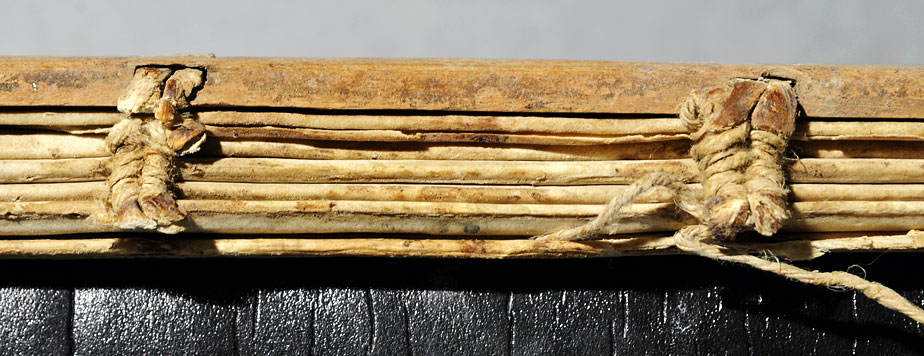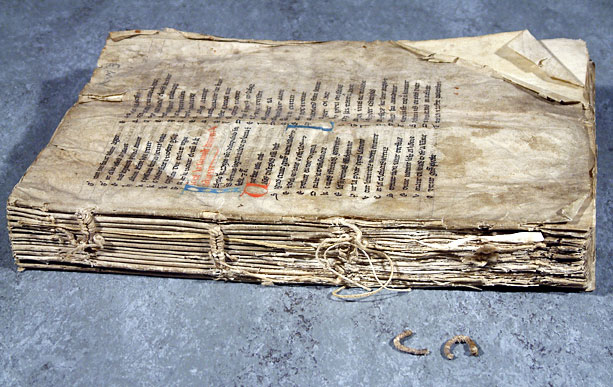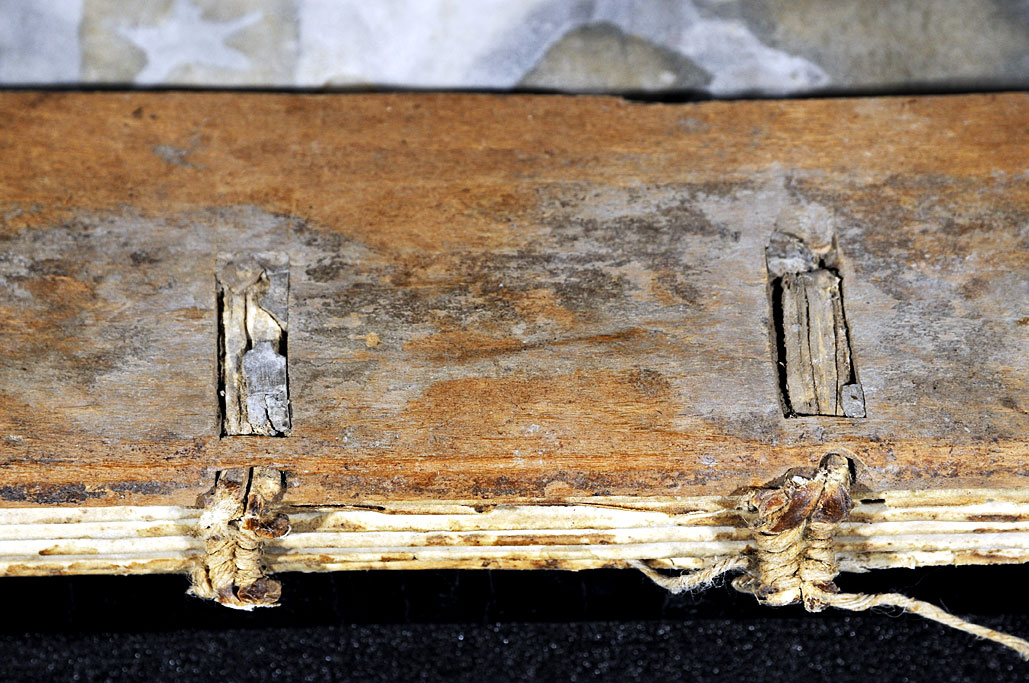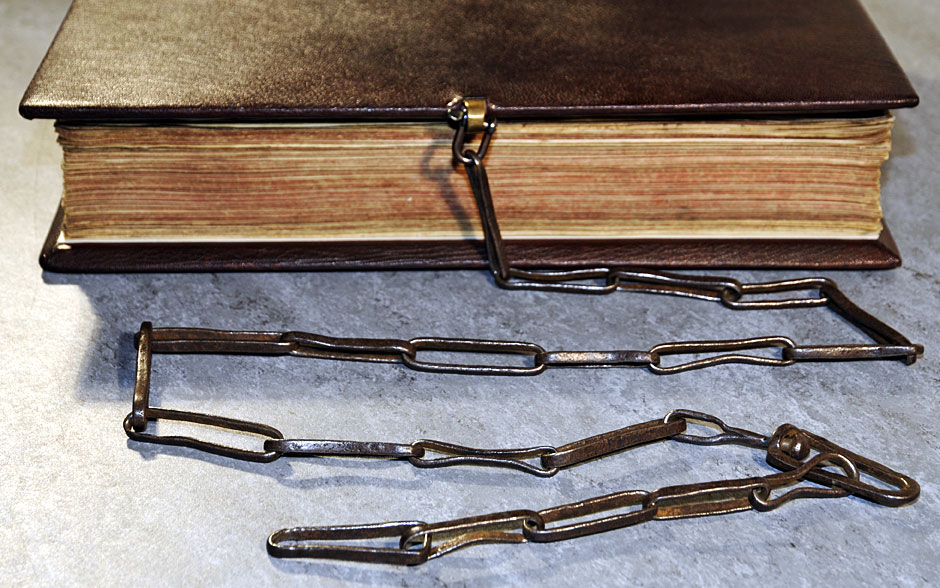Binding
Sewing
When the copying of a text had been completed, and any decorative scheme planned had been executed, the resulting collection of quires or gatherings containing the text could be sent for sewing and then binding. The gatherings would have to be assembled in the correct order to make the complete book. Early medieval scribes sometimes numbered their gatherings by writing letters or numerals. Here is an example of a ‘t3’ signature, indicating the third leaf of the 20th quire labelled ‘t’.

Sign to help the ordering of completed loose leaves for sewing, from John Gower, ‘Confessio Amantis’, WLC/LM/8, f. 155r
By the twelfth century scribes also used another way of keeping their work in order. This was to write at the bottom right-hand side of the last page of the gathering the first few words of the text in the next gathering so that the binder could match consecutive quires. These are called ‘catchwords’ and are generally evidence of professional book production.

Catchword, ‘he graspeth’, from John Gower, 'Confessio Amantis', WLC/LM/8, f. 24v
When quires were assembled in the correct order, they would be sewn together to form a book. In the early Middle Ages this might have involved sewing gatherings together with thread through the central fold of the quire. However, throughout the rest of the period it was more usual to sew the gatherings onto leather cords or thongs which ran horizontally across the spine which had been formed by the pile of ordered quires.

Sewing onto cords, part of prayer book WLC/LM/11

WLC/LM/3, before conservation, unbound, showing damage to stitching at the spine
The ends of the cords onto which the stack of quires had been stitched would then be threaded through holes and channels which had been drilled into wooden boards. In Britain these boards were usually made from oak, which makes the bound book extremely heavy to lift but which can help to flatten the naturally springy vellum or parchment of the manuscript. The quires were then secured onto the boards with dowels or wooden pegs. The boards used for binding books were often very slightly larger than the manuscript, their edges neatly bevelled.

Cords threaded inside wooden board, prayer book WLC/LM/11 before conservation

Inside view of front cover of WLC/LM/9, showing cords threaded inside wooden board
Flyleaves and pastedowns
When manuscripts were no longer deemed of value or use to their owners, new uses were often found for them because the materials from which they were made retained a practical value. Leaves from unbound manuscripts could also be used as fly-leaves, or as paste-downs to reinforce stitching in a binding. This was the fate of the'Gui de Warewic' fragment, which comprises two strips of parchment from a manuscript of the Anglo-Norman romance, which was found inside the binding of an early printed book of sermons from Oakham Parish Library. Old pages from a service book were also re-used in the binding of a copy of 'L'Estoire del Saint Graal'.

'Gui de Warewic' fragment, Special Collection BX1756.J6

Leaves from a service book, used in the binding of 'L'Estoire del Saint Graal',WLC/LM/7, inside front cover
Book Bindings
The decorative nature of the wooden binding boards varied considerably. Sometimes they remained plain and unadorned. Others were covered with leather, either immediately or later in their history.

Plain leather cover of 'L’estoire del Saint Graal', WLC/LM/7
Stamped leather bindings became popular in northern France from the late twelfth century and this method of decorating bindings became more widespread by the late fifteenth century. The stamps used to decorate the bindings were small metal devices which were pressed into the leather to create impressions of flowers, leaves, animals or figures. Some binding boards were covered with embroidered or woven textiles, but very few of these have survived from before the sixteenth century.
The design on the prayer book below has been achieved by blind stamping. Identification of the designs on these boards show them to be the work of a prolific Oxford binder, and enable us to date the binding to sometime in the 1470s. Digitisation allows the enlargement and enhancement of details. The designs which feature on this binding include a hare, a lamb with flag, and a dolphin with arched back.

Detail of stamped Oxford binding on the back board of prayer book, WLC/LM/11
Straps and chains
This copy of 'Speculum Vitae', written in the early fifteenth century, retains an early, perhaps original binding. Leather straps are attached to the binding to keep the book shut. Over time the parchment leaves have altered their shape, putting great stress on the spine. It is not now possible to close the book fully.

'Speculum Vitae', WLC/LM/9
The Rushall Psalter was originally a ‘chained book’, showing how valuable it was. The chain that would have been attached from its binding to the lectern in the parish church (perhaps at Rushall) have been preserved. The manuscript itself contains a poem which describes how the book is 'tacched [fastened] with a cheyn' and curses anyone who attempts to remove it from its rightful place!

Original medieval chain attached to modern binding of the Rushall Psalter, Me LM 1

Ownership poem in the Rushall Psalter, Me LM 1, f. 20v
"This present book legible in scripture
Here in this place thus tacched with a cheyn
Purposed of entent for to endure
And here perpetuelly stylle to remeyne ..."
Unbound and composite volumes
Medieval books were not always owned or circulated in bound form. It was common for many books, with the exception of the most expensively produced, to circulate without bindings. A dirty or worn outer folio of a medieval manuscript is often a sign that it circulated without bindings for a considerable period of time.
It is not always clear at what point manuscripts took on the form in which they survive in libraries and archives today. Some quires or groups of quires were clearly originally intended to be bound together. Others may have been assembled to make one book by later owners. A composite manuscript is a manuscript compiled from quires or booklets that were not originally intended to be put together.
The Rushall Psalter is an excellent example of such a book. The liturgical part of the manuscript is a high quality production, neatly copied onto vellum, and decorated with penwork initials, illuminated borders and historiated initials. But it is prefaced by one quire, plus further miscellaneous sheets of parchment, containing a more informally copied collection of English texts in verse and prose, some copied at about the same time as the liturgical manuscript, and others in the sixteenth century. The miscellaneous leaves are not uniform in size and shape, and do not follow the layout and decorative scheme of the main body of the manuscript. However, these leaves seem to have been placed at the front of the manuscript relatively early on in its history. The English texts are clearly of significance to members of the Harpur family, who owned the liturgical manuscript.

Example of family notes in fifteenth-century handwriting, on one of the miscellaneous leaves bound with the Rushall Psalter, Me LM 1, f. 195v
Next page: Glossary